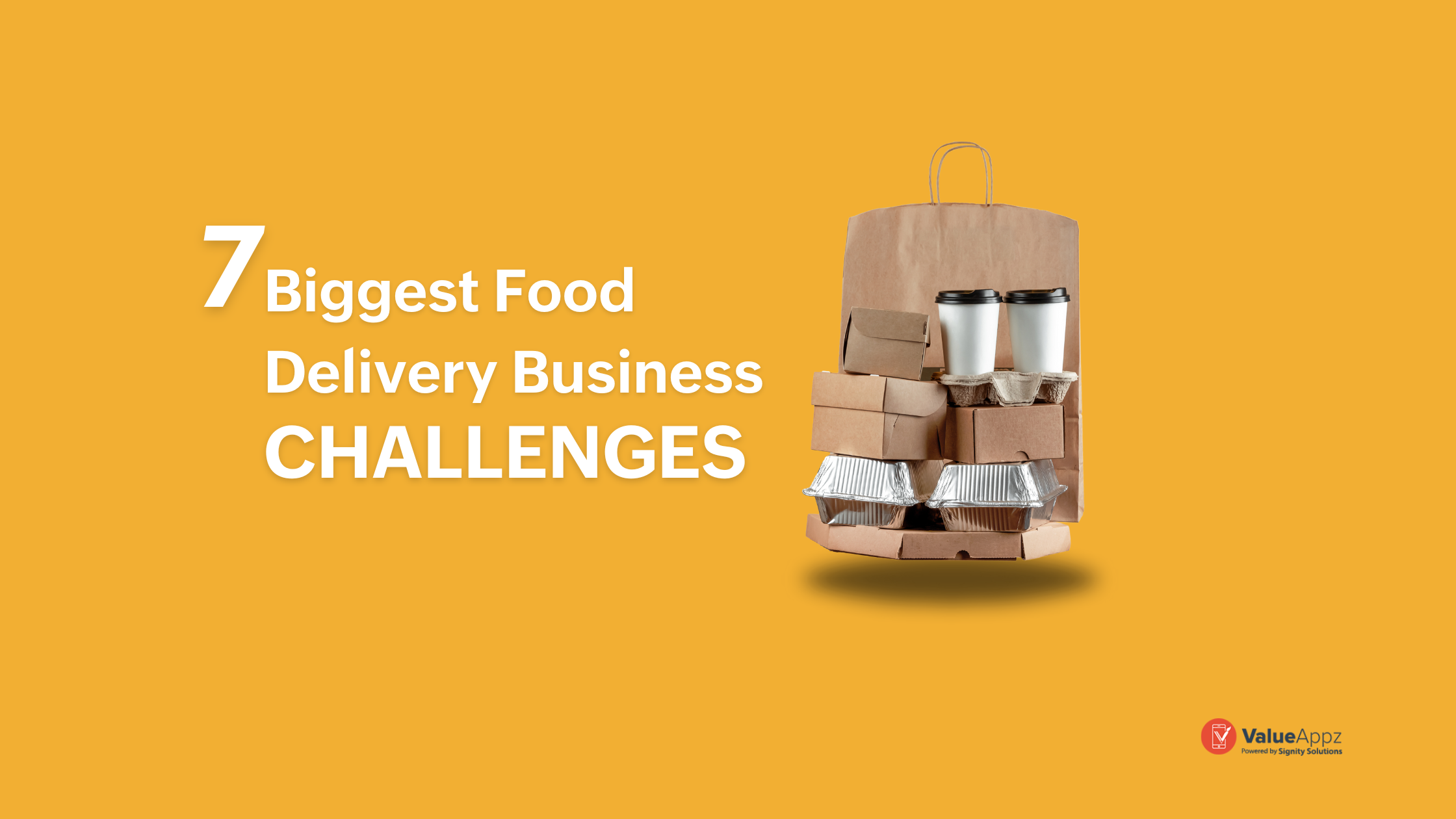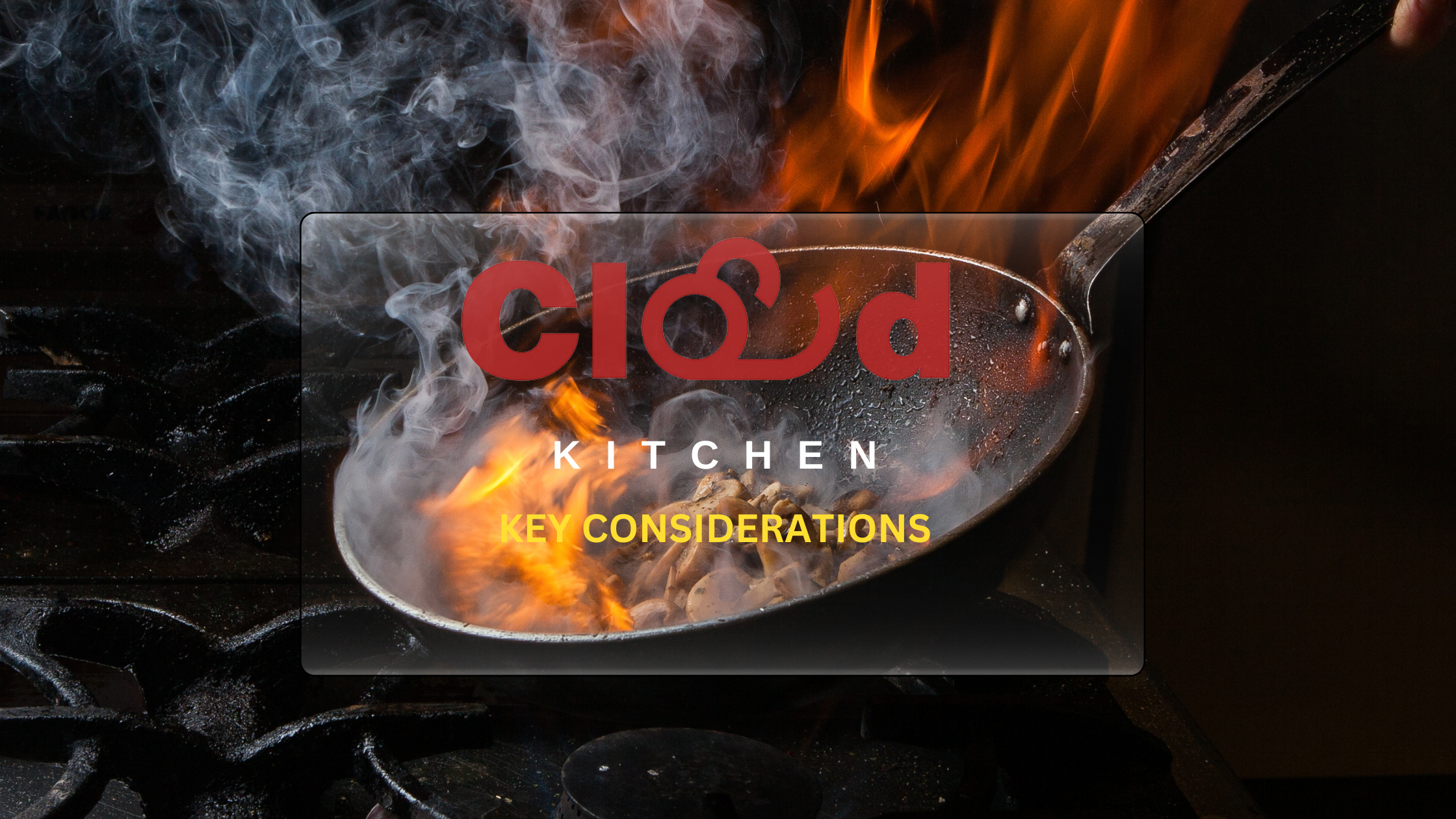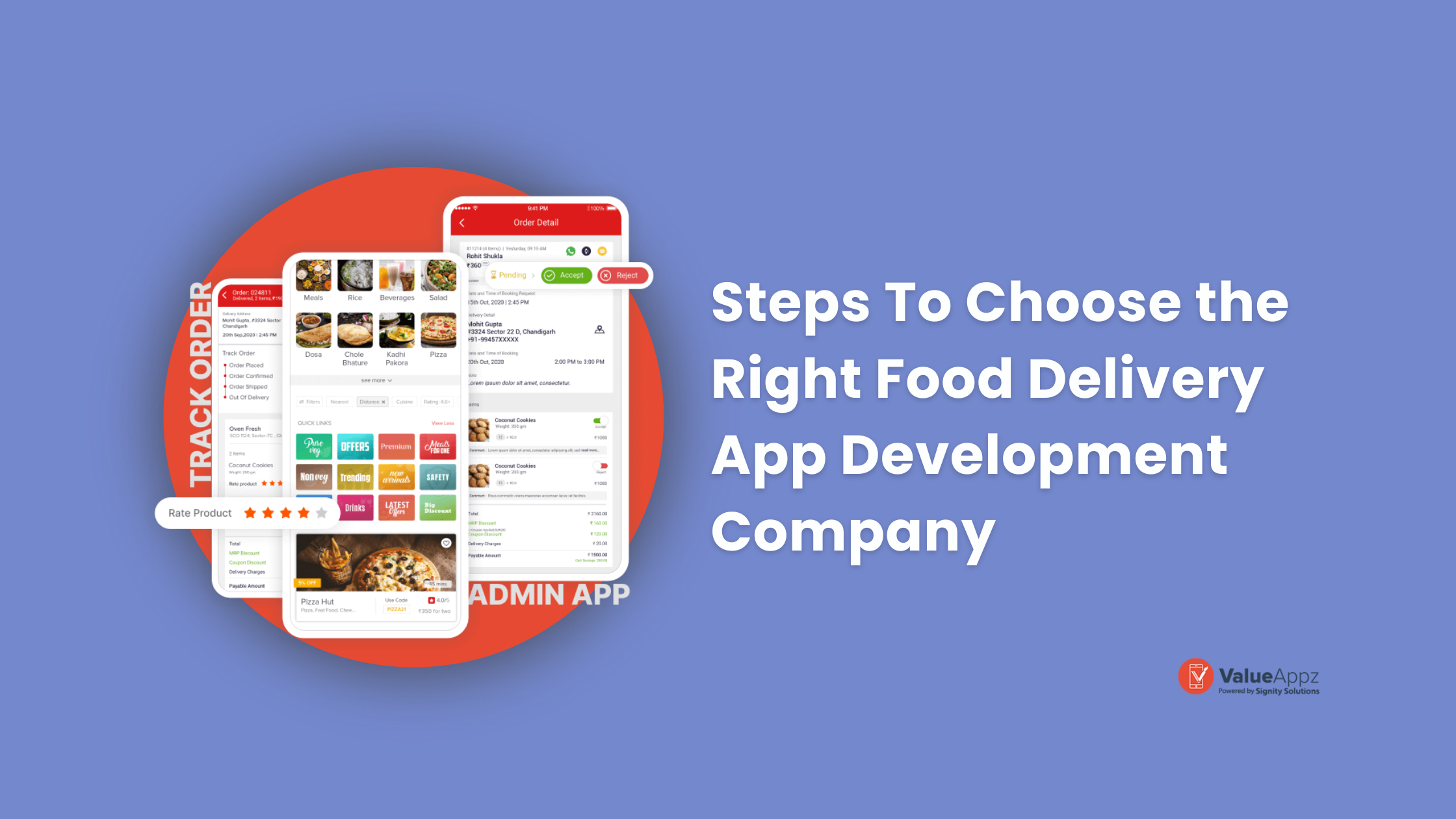7 Biggest Challenges Faced By The Food Delivery Businesses [2024 Edition]

Quick Summary: Though food delivery businesses have become a trend, the brands have to face various hurdles. What are these challenges faced by the food delivery businesses? And what are the perfect solutions to it? This blog will explain in detail how startups, small businesses, and established brands can easily handle these challenges.
Food delivery platforms have become one of the fastest growing as they provide users great convenience by letting them order their favorite cuisine from their preferred outlet with just a few taps.
This industry is expected to grow to US$ 97,291.58 million by 2032. Quick deliveries, engaging design, ease of ordering, and online support are some of the primary reasons for this growth.
Though the food delivery platform seems to be functioning smoothly at the customer end, there are several challenges of such an app that can be noticed by the many restaurant owners and admin end.
Once the food delivery business is in the market, it must evolve over time to attract more customers and enhance retention. Furthermore, the changing trends and rising customer expectations have created even more challenges.
Before we begin to look at the top challenges faced by this market, let’s understand how this industry has evolved with time.
Table of Contents
How Has the Food Delivery Business Evolved Over Time?
Over time, food delivery businesses have seen a tremendous change in how they operate and customers’ preferences. From tech stack to delivery options, payments, customer experience, and so on, this industry is changing at a fast pace.
The table below shows how quickly the industry changed compared to the early 21st century.
| Aspect of Food Delivery | Early 21st Century | Recent Trends (Mid 21st Century) |
|---|---|---|
| Ordering Process | Online platforms | Mobile apps, AI chatbots |
| Menu Variety | Diverse options, dietary preferences | Health-conscious, eco-friendly options |
| Delivery Speed | Faster with online platforms | Real-time tracking, express delivery |
| Payment Methods | Digital wallets, mobile payments | Contactless payments, cryptocurrency |
| Marketing | Digital marketing, social media | Influencer marketing, personalized ads |
| Customer Experience | Enhanced convenience, reviews | Personalized recommendations, AR/VR dining |
| Environmental Impact | Sustainability initiatives | Green packaging, carbon-neutral delivery |
| Competitors | Aggregators, global giants | Virtual restaurants, dark kitchens |
| Technology | Emergence of the internet | AI, ML, Blockchain |
Let’s look at the biggest challenges food delivery businesses face and how these can be handled, along with some tips to increase food delivery business sales.
Top 7 Food Delivery Business Challenges
If you own a food delivery business, you would already know how hard it is to manage it. From attracting customers to retaining them, implementing unique strategies to , and reaching the target market, meal delivery service can be hectic.
But don’t worry; we have listed the most common challenges that online food delivery services face and provided the best tips to tackle them.
1. Shift in Consumer Demand
One of the first obstacles food delivery businesses face is changing customer preferences. Eaters are increasingly preferring to order food online instead of dining out. It has created a crowd that is hard to manage for the food delivery and service industry.
Moreover, this has led to a rise in the online restaurant industry, which has introduced new challenges for small food delivery businesses, such as engaging and retaining customers, creating a steady client base, and adapting to the industry’s evolving economic structure and business risks.
As a result, one must be able to adapt to these changes by offering high-quality services that meet customer expectations.
The Solution:
Investing in a food delivery app development can be a game-changer for your business. Partnering up with a reliable on demand food delivery app development company can help you create a robust and user-friendly app that meets your business requirements and enhances your brand image.
Additionally, a dedicated food delivery app can simplify collecting customer feedback and understanding their preferences. This will help you improve your customer satisfaction and give you an edge over your competitors.
2. Unstable Market Prices
Another difficulty that food delivery businesses face is unstable market prices. The food industry is subject to numerous factors affecting food prices, such as inflation, supply and demand fluctuations, and government regulation changes.
Therefore, food delivery platforms and services may struggle to keep up with market prices and find the right pricing strategy to maintain profitability.
It can have the biggest impact on the company’s margins. If the cost of ingredients rises suddenly, a food business may need to adjust its prices accordingly, which can be difficult if they have already set a fixed pricing strategy.
Similarly, if a delivery company does not adjust its prices to account for rising costs, it risks losing money on each order and damaging its bottom line.
The Solution:
To handle the uncertainty of the prices, you can adopt strategies like establishing long-term partnerships with the providers and negotiating contracts that include pricing stability clauses.
You can also use data analytics and food delivery industry market insights to track market trends and adjust pricing strategies accordingly. Further, you may also focus on operational efficiency to reduce costs and improve margins for the delivery app.
3. Adherence to Food Quality Standards
The industry of meal delivery faces considerable issues related to food quality requirements. First and foremost, maintaining food quality while in transit is a top priority. Food can be transported over vast distances, frequently facing obstacles like temperature changes and traffic jams.
These circumstances may impact the freshness and safety of the food. Second, ensuring uniform quality across various dining establishments and delivery services can take time and effort. The food delivery sector collaborates with a variety of cafes and restaurants with distinct standards and procedures.
Guaranteeing that each place follows strict food safety guidelines, appropriate product procurement, and uniform cooking techniques is crucial. Deviation from these guidelines may result in changes in the quality of the food, which can have a negative impact on client satisfaction and the reputation of the meal delivery service.
The Solution:
To address these concerns, the admin set up quality standards for restaurants and delivery partners to adhere to. These standards may include food safety guidelines, quality of ingredients, and packaging requirements.
Restaurants may also be required to follow strict preparation and handling protocols. Delivery partners may need to use insulated bags to ensure the food is delivered at the right temperature.
Despite these measures, food quality issues can still arise in food delivery apps, such as food not meeting customers’ expectations or being unsafe to consume.
In such cases, food delivery applications usually provide customer support options to report the issues, and customers may receive refunds or credits to resolve the issue.
4. Managing Customer Expectations
The food delivery sector faces severe obstacles due to shifting consumer expectations. Customers today want quicker, more convenient, and tailored services as a result of technological improvements and changing consumer preferences. Due to this change, meal delivery services have had to adjust to satisfy shifting customer expectations and stay competitive. Customers now demand frictionless payment options, real-time order tracking, and increased transparency in the meal delivery process.
These demands require investments in cutting-edge logistics, customer support, and user-friendly applications or websites, which can be difficult and expensive. If these expectations aren’t met, you risk losing clients to other businesses that can provide a better experience.
Further, these demands also raise the bar for food quality and variety. Food lovers have started to prioritize healthier alternatives, dietary preferences, and customization options. Hence, the businesses must collaborate with several ranges of restaurants to handle complex order customization requests.
The Solution:
To manage customer expectations, the food delivery businesses must focus on key solutions. Investing in the latest technology and logistics is crucial for real-time order tracking and efficient delivery services.
Further, prioritizing customers’ concerns and providing transparent communications can help enhance customer satisfaction. Also, businesses must continuously gain users’ feedback to ensure they get the best solutions.
5. Improper Food Handling
Food handling is another leading challenge in the food delivery sector. Improper food handling can result in various health consequences for customers and damage the business’ reputation.
With the business’ popularity, food handling gets even more challenging as several orders have to be fulfilled at a particular time. Moreover, careless food handling can lead to food quality and presentation issues.
Each customer expects its food to be fresh, visually appealing, and packed correctly when it arrives. Any food mishandling leads to negative feedback on the platform that can further damage the brand’s reputation.
The Solution:
To address this problem, businesses must implement various solutions. Firstly, brands can provide training programs for food handlers to ensure food is delivered safely. Secondly, setting cellar guidelines and procedures for food delivery will guarantee that each order is delivered in the best possible way.
For example, the marketplace model of Uber Eats manages proper food handling through strict guidelines and partnership with various restaurants to ensure compliance with food safety regulations. Restaurants are required to follow strict hygiene standards, including maintaining clean kitchens, proper food storage, and so on.
6. Managing Logistics
Logistics is another concern in food delivery services, as this industry is time-sensitive. Customers expect their food to be delivered quickly and hot, so companies must carefully manage their food delivery business plan, routes, schedules, and staffing to ensure timely food deliveries everywhere.
In addition, food safety regulations require that perishable items be stored and transported at specific temperatures, which adds a layer of complexity to logistics planning. There can be several questions like:
- Whether to keep the distribution radius confined to a few regions or to appeal to a broader geography
- Is there scope for having higher orders from a particular location?
- Allocating the correct number of vehicles
- Ensuring the food quality
Food delivery companies often work with various partners, including restaurants, delivery drivers, and third-party logistics providers, each of which may have different capabilities and requirements.
It can make coordinating deliveries efficiently and effectively hard, especially during peak times when demand is high.
The Solution:
To address the logistics challenge in the food delivery business, companies need to adopt a comprehensive approach that includes several key strategies. One such method is to invest in technology that enables real-time tracking of orders, delivery routes, and driver performance.
It can help companies optimize delivery networks, improve efficiency, and reduce costs.
For example, food delivery businesses can use machine learning algorithms to do market research to predict demand patterns and adjust their delivery schedules accordingly or use GPS tracking to monitor delivery drivers’ locations and reroute them if necessary. Lessons can also be taken from other sectors. For instance, understanding cold chain logistics in a healthcare context can bolster food transportation strategies immensely, keeping costs down and reducing waste.
7. Rising Competition
The presence of larger players makes it difficult for startups and small businesses to compete, as the leading players sometimes may be able to offer lower prices due to their economies of scale. It can pressure smaller companies to reduce costs, impacting their margins and profitability.
Bigger players may have more extensive marketing budgets and brand recognition, making it easier for food businesses around them to attract customers. Top food delivery companies often have more extensive partnerships with restaurants and other food service providers.
It can make it challenging for smaller businesses to establish partnerships with these providers, limiting their offerings and making competing on a level playing field more difficult.
The Solution:
One of the best ways to fight with the competition is to focus on your unique value proposition for competitive advantage. Differentiate yourself by offering specialized cuisine, providing personalized customer service, improving delivery speed and accuracy, and leveraging technology to enhance the user experience.
Also, expand the network with local restaurants and outlets for a broader partnership to give customers various options.
Serving Success in the Food Delivery Industry: How ValueAppz Can Transform Your Business
In this rapidly growing food delivery industry, meeting the customers’ expectations and managing complex logistics can be difficult. At ValueAppz, we understand these challenges and have a proven track record of helping entrepreneurs thrive in this competitive market.
Our expertise in food delivery app development services, groundbreaking tech solutions, and tailored strategies will empower your business to address the challenges mentioned above. We have you covered, from developing a user-friendly, real-time tracking app to optimizing delivery networks and ensuring food safety compliance.
So, don’t let these challenges hold you back. Contact ValueAppz now to discover how we can tailor our services to your unique needs and help your brand succeed in this competitive market.
Key Takeaways
- Due to shifting consumer demands and technical breakthroughs like mobile apps, real-time tracking, and AI chatbots, the food delivery industry has undergone tremendous change.
- Despite the convenience for consumers, food delivery services deal with several difficulties, such as changing consumer demand, fluctuating market prices, adherence to food quality standards, managing client expectations, incorrect food handling, complicated logistics, and growing competition.
- These issues can be overcome by diversifying the menu to cater to customer preferences, investing in food delivery services with cutting-edge features, forming long-term partnerships for price stability, establishing quality standards for food partners, and effectively managing logistics with technology.
- Data analytics will be essential for 2023 food delivery companies that want to understand consumer preferences and market trends. Utilizing data improves decision-making, pricing tactics, and customized menu selections, increasing customer happiness.
Frequently Asked Questions
Q1. What are the Current Challenges in the Food Delivery Industry?
The challenges faced by the food delivery industry are rising competition, maintaining quality control, and adhering to food safety standards.
Q2. How can Food Delivery Businesses Effectively Manage and Optimize their Operations to Navigate the Challenges?
Food delivery businesses can easily manage and optimize their operations by implementing efficient logistics, leveraging data analytics, and investing in the latest technology.
Q3. How can I Navigate Supply Chain Disruptions Affecting the Food Industry?
To navigate supply chains disrupting the food industry, you can consider diversifying suppliers, creating contingency plans, and maintaining open communication with suppliers.
Q4. How can I Adapt to Changing Consumer Preferences in the Food Delivery Sector?
To adapt to consumers’ changing preferences, you must focus on providing a diverse menu, customized options, healthier choices, and sustainable packaging.
Q5. How do Food Delivery Services Ensure Food Safety During Delivery?
Food delivery services ensure food safety by implementing strict hygiene protocols, providing training to delivery partners, and using insulated packaging to maintain food’s freshness.
THE AUTHOR
Amrita Singh
With a background in Digital Marketing spanning over five years, I bring a unique perspective to my writing and have developed a keen understanding of the ever-evolving digital landscape. I focus on creating content that is relevant and easy to understand.

Get ready to digitally transform your business.
Let our team help take your business to the next level. Contact us today to get started on finding the perfect solutions for your business needs.











